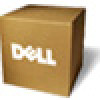Dell PowerVault 700N Dell PowerVault NAS Solution iSCSI Deployment Guide - Page 16
Creating a Virtual Disk, Completing the Create Virtual Disk
 |
View all Dell PowerVault 700N manuals
Add to My Manuals
Save this manual to your list of manuals |
Page 16 highlights
f Select Next. NOTE: IQNs work regardless of the DNS configuration. You can also specify the IP address or MAC address of the Initiator regardless of DNS configuration. The option of specifying a DNS domain name is built into the iSCSI Software Target snap-in. While using DNS names, you must configure DNS correctly (including forward and reverse lookup zones) and specify the fully qualified domain name (FQDN) of the Initiator. If you are unable to connect the Target to the Initiator after specifying the Initiator FQDN, run the nslookup InitiatorIP command on the target server to verify if reverse lookup is enabled correctly. If the nslookup command fails, it indicates that the DNS reverse lookup is not configured. In such a case, reconfigure the Target to use the Initiator IQN, IP address, or MAC address. 10 The Completing the Create iSCSI Target wizard appears. Click Finish. Creating a Virtual Disk 1 Right-click the newly created Target and click Create Virtual Disk for iSCSI Target. The Create Virtual Disk wizard appears. Select Next. 2 To create a file, choose the Browse option, select a volume on the storage array and type a file name with an extension .vhd. For example, create Z:\vol1.vhd, where Z is the mounted volume from storage array and vol1.vhd is the filename. Select Next. 3 In the Size screen, choose the appropriate size from Currently available free space and click Next. 4 The Description screen may appear. Enter the virtual disk description, if required and click Next. 5 In the Add screen, select the Target name and click Next. 6 The Completing the Create Virtual Disk wizard appears. Click Finish. CAUTION: If multiple hosts access the same Target, data corruption may occur. For more information, see "Enabling Multi-Path on the Initiator" on page 45. NOTE: You can create multiple VHDs on the same volume. 16 Setup Steps for Initiator-Target Connection















